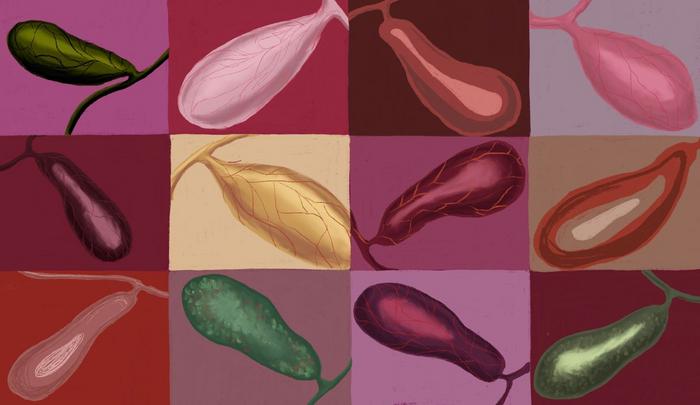Although surgery is a common treatment for patients diagnosed with biliary dyskinesia, or functional gallbladder disorder, a West Virginia University medical researcher is questioning why the practice has become so widespread when little clinical research is available.

Credit: WVU Illustration/Aira Burkhart
Although surgery is a common treatment for patients diagnosed with biliary dyskinesia, or functional gallbladder disorder, a West Virginia University medical researcher is questioning why the practice has become so widespread when little clinical research is available.
Biliary dyskinesia is a gallbladder disorder in which patients don’t have gallstones yet experience similar pain in the upper right quadrant of the abdomen, usually following a fatty meal, that lasts 30 minutes or longer and is significant enough to disrupt normal activities. In the United States, it’s the most common indicator for gallbladder removal — cholecystectomy — in children and accounts for between 10% and 20% of the surgeries in adults.
“When you see the number of cases of surgery increasing, you just want to make sure that it’s being done for the right indications and that the patients are benefiting, but that’s where there were so many gaps in the data,” said Dr. Bryan Richmond, chair and professor at the WVU School of Medicine Charleston Campus Department of Surgery. “The practice of cholecystectomy for this condition is not embraced in other countries.”
While doctors don’t know what causes patients to develop the disorder, they know it results when the gallbladder doesn’t contract as it should to release bile through the ducts.
To properly diagnose functional gallbladder disorder and select which patients would best benefit from the surgery, Richmond said a combination of factors must come together: biliary pain, the absence of gallstones and a low gallbladder ejection fraction — how much bile the gallbladder releases when it contracts.
To measure the ejection fraction, clinicians conduct what’s called a cholecystokinin-cholescintigraphy, CCK-HIDA, scan. However, Richmond said that test is sometimes misused.
“What makes it tricky is the scan itself doesn’t predict the disease because the values that are considered normal versus abnormal are calculated on normal healthy subjects, not patients with pain,” he said. “It has to be considered in the context of the patient’s symptoms, the combination of classic biliary symptoms with supporting findings on your scan to suggest surgery.”
Richmond’s invited manuscript, published in the journal JAMA, discusses both supporting and lacking evidence for the prevalence of the surgery and suggests the need for future studies. The publication’s editors asked Richmond to write the article after hearing his presentation on the topic at the American College of Surgeons Clinical Congress.
He cites a 1991 study that focused on whether patients benefitted from the surgery and a 2016 randomized control trial he and his colleagues conducted to refine the research. Both found that patients with classic gallbladder pain symptoms, no gallstones and a low ejection fraction were most likely to experience successful results from surgery. Still, he said neither are convincing enough to warrant the increasing number of operations.
“The 1991 study had fewer than 30 patients in it — not enough to establish such a dramatic change in practice,” Richmond said. “Our trial, which was published in Journal of American College of Surgeons, was still a very small study. At the end of the day, we still don’t have large amounts of data to support the practice.”
Richmond said he thinks additional research with a larger group of participants is needed to make sure surgery is the best option for patients based on the combination of their symptoms and ejection fraction scan results. He said he expects the findings would validate the 1991 and 2016 studies.
“My next goal would be to obtain funding for a larger multicenter trial to get enough numbers and standardization of the inclusion criteria and extended follow up to determine success versus failure,” he said. “I think we can show that in well selected patients, cholecystectomy provides durable symptom relief in biliary dyskinesia and that if the patients don’t have classic symptoms, the further that they depart from those classic symptoms, the less likely the chances of success will be.”
Currently there is no treatment for functional gallbladder disorder other than pain medications and avoiding foods that trigger the pain. However, until further research is conducted, Richmond suggests physicians remain vigilant in making their decisions for surgery.
“It’s not a dangerous or progressive condition, it’s a very different disease process than that of gallstone related disease,” he said. “It’s really important that clinicians be honest with their patients about what the implications of this diagnosis are. That is that if it goes untreated, it may remain uncomfortable and lifestyle limiting, but it doesn’t rise to the level of danger, and also that the results of having cholecystectomy performed for this condition historically have not been as good as those with gallstone disease in terms of relief of pain.”
Journal
JAMA
Article Title
Biliary Dyskinesia—Controversies, Diagnosis, and Management
Article Publication Date
3-Jul-2024



